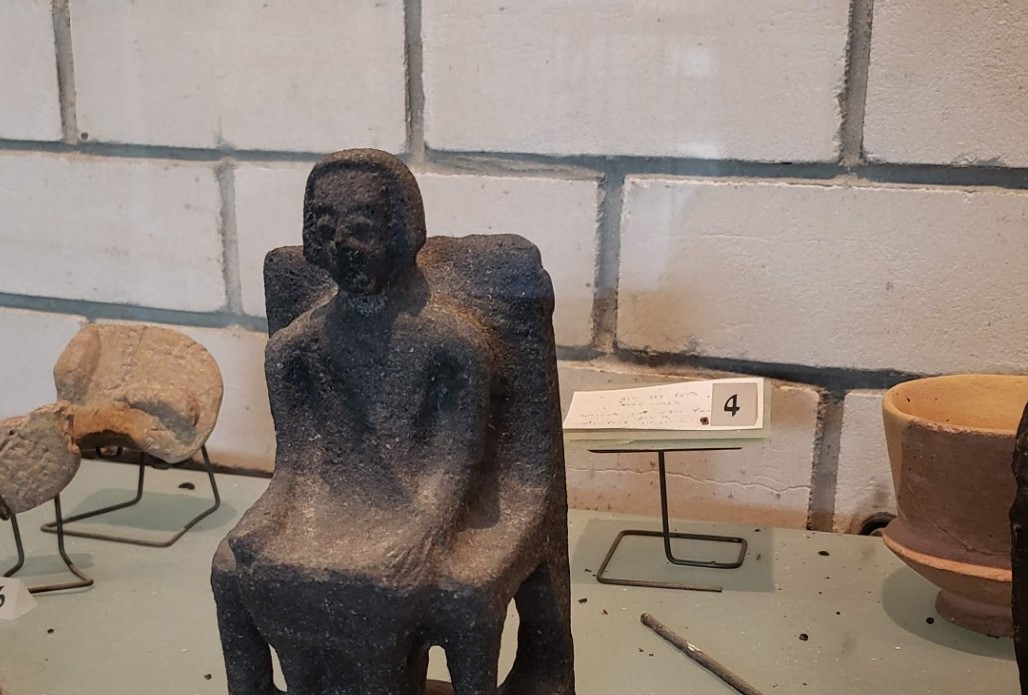Digging Deeper: The Chemarims
Author: Mr. Kenneth Frank | Faculty in Theology, Living Education
Estimated Reading Time: 8 min., 19 sec.
Did you know that in ancient Israel a mysterious group of religious officials known as Chemarims served in God’s sanctuary and at pagan shrines?
Some authorities suggest they were attired in black robes. Historically, black robes have been associated with clergy in the Christian world. The Catholic order, the Jesuits, was referred to as “Black Robes” by native peoples in the Americas during colonization. This Digging Deeper explores this unfamiliar term Chemarims to discover something about who they were and why they were referred to by this name.
The word Chemarims appears only once in our King James Bible. Here is the verse:
(Zephaniah 1:4) “I will also stretch out mine hand upon Judah, and upon all the inhabitants of Jerusalem; and I will cut off the remnant of Baal from this place, and the name of the Chemarims with the priests.” Notice that this worship is associated with the god Baal. This verse describes two groups of religious leaders, as explained by The New English Translation Notes: “The first word (כְּמָרִים, kemarim) refers to idolatrous priests in its two other appearances in the OT (2 Kings 23:5, Hosea 10:5), while the second word (כֹּהֲנִים, kohanim) is the normal term for ‘priest’ and is used of both legitimate and illegitimate priests in the OT” (e-Sword 13.0).
Who were the Chermarims?
The English word Chemarims is related to the Hebrew word (komer), which appears in two other verses also associated with heathen worship:
(Hosea 10:5) “The inhabitants of Samaria shall fear because of the calves of Bethaven: for the people thereof shall mourn over it, and the priests [komer] thereof that rejoiced on it, for the glory thereof, because it is departed from it.”
(2 Kings 23:5) “And he [King Josiah] put down the idolatrous priests [komer], whom the kings of Judah had ordained to burn incense in the high places in the cities of Judah, and in the places round about Jerusalem; them also that burned incense unto Baal, to the sun, and to the moon, and to the planets, and to all the host of heaven.”
Good King Josiah rid his land of these idolatrous priests (2 Kings 23:5). The NIV Study Bible, concerning Zephaniah 1:4-6, states that this passage: “Seems to indicate that Zephaniah’s main ministry took place before 621 bc, since the practices condemned here were abolished in Josiah’s reforms (see 2 Kings 23:4-16 and notes). Perhaps Zephaniah’s message was partly instrumental in motivating King Josiah to undertake his reforms (cf. 2 Chronicles 34:1-7)” (Tecarta Bible App). Josiah was one of the best kings of the House of Judah. His spiritual reformation of cleansing his empire of paganism is an epic Old Testament story.
Those in black robes
Several older sources associate the Chemarims with those who were attired in black robes. For example, The Cyclopedia of Biblical, Theological and Ecclesiastical Literature by John McClintock and James Strong declares: “According to Gesenius (Thes Hebrews p. 693), the corresponding Syriac word signifies ‘a priest in general; but this, as well as other Syriac words relating to divine worship, is restricted by the Hebrews to idol-worship. As to the etymology, the singular form כֹּמֶר, ko´mer, is properly blackness, sadness, and concretely, one who goes about in black, in mourning, hence an ascetic, a priest'” (e-Sword 13.0).
Then, relating this to Christian history, this source continues: “The priests who officiated in the service of the golden calves at Dan and Bethel were called chemarim (see the other passages referred to). Even to this day the Jews retain the word, and apply it in derision to Christian ministers, on account of their black robes” (e-Sword 13.). John Gill’s Exposition of the Bible describes some clergy today even more particularly: “The word is used now by the Jews for Popish monks that live in cloisters; and Elias Levita (m) thinks these here are so called from their living in such like recluse places” (Ibid.).
An older work from the 1600s by John Trapp called A Commentary on the Old and New Testaments is even more pointed when it refers to these religious leaders as “Baal’s chimney chaplains” and then asserts: “The Vulgate rendereth it Aedituos, underlings to the other priests: Elias in Tisby, saith they were such as were shut up in cloisters, Chemarim Atrati they are called, either from their black garments, or because they were smutched with burning incense, or from the brandmarks they had superstitiously set upon their bodies, or because of their pretended fiery zeal and fervency in their religion, such as are the Sacrifici Seraphici among the Papists, who falsely and foolishly call them the lights of the world, sc. to light them into utter darkness” (e-Sword 13.0). We are not used to such bold declarative statements today!
Adam Clarke’s Commentary on the Bible in its comment on 2 Kings 23:5 goes even further with this challenging thought: “Probably they were an order made by the idolatrous kings of Judah, and called kemarim, from כמר camar, which signifies to be scorched, shriveled together, made dark, or black, because their business was constantly to attend sacrificial fires, and probably they were [wore] black garments; hence the Jews in derision call Christian ministers kemarim, because of their black clothes and garments. Why we should imitate, in our sacerdotal dress, those priests of Baal, is strange to think and hard to tell” (e-Sword 13.0). That is certainly something for current clergy to consider seriously!
A Commentary on the Holy Bible by Thomas Coke also relates the word to black robes: “Bishop Patrick thinks, that they were so called from being clothed in black; for the Egyptians, as well as many other pagan nations, made use of black garments when they sacrificed to the infernal deities: in opposition to which, the Jewish priests were clothed in white at their sacrifices” (e-Sword 13.0).
Uncertain etymology
However, not all sources associate Chemarims with black robes. A comparatively newer source, The Zondervan Pictorial Bible Encyclopedia, Vol. 1, edited by Merrill C. Tenney, declares the word’s uncertainty: “Its etymology is uncertain, none of those suggested being widely accepted … However, in the OT it is used only of the priests of idols or foreign gods, thus with an unfavorable sense” (Regency Reference Library, 1976, p. 786).
Another reference work, The International Standard Bible Encyclopedia’s article on Chemarims, also expresses its uncertain meaning: “The question of the root idea of the word remains unsettled. The traditional supposition, which finds some support even among modern scholars, is that the verbal form means ‘to be black,’ the priests being supposed to have been clad in black. But it is doubtful whether the root had this meaning. Another conjecture takes the root to mean ‘to be sad,’ the priest being a man of a sad countenance, an ascetic” (e-Sword 13.).
This source then adds this further explanation: “It is at all events probable that the priests, both in Israel and in the surrounding nations, employed white vestments, rather than black, when in the performance of their official functions. According to the Mishna, Middōth, verse 4, a Levitical priest who had become disqualified for service put on black garments and departed, while the others put on white garments and went in and ministered. The reference to the Baal worship in 2 Kings 10:22 seems more congruous with this view; hence, probably blackrobed priests (Chemarim) of Baal and the unfaithful priests of Yahweh shall be cut off together. G. A. Smith (BTP, II, 56) reads ‘the priestlings with the priests'” (e-Sword 13.0).
Let the Bible interpret itself
As you can see, the original meaning of Chemarims is still not fully understood. However, whatever is meant, our English Bible defines it sufficiently using English words. Notice that in all three instances of the Hebrew word komer, the Bible has given its definition as idolatrous priests. This is an important principle of Bible study: search for a particular English word with an English concordance of the Bible to find other verses that explain its meaning. This way, the Bible interprets the Bible.
Another useful study tool is to look up the original Hebrew or Aramaic word for the Old Testament or the original Greek word for the New Testament and perform searches in concordances for these original languages. Today, this process is very fast and convenient using electronic Bible study tools available for various devices. However, beware of lexicon definitions. Some of the classic original language lexicons were produced by men who gave definitions for original words of the Bible by quoting non-biblical dictionaries, literature, or other sources. Instead, rely on the word of God to defines its own words.
Whatever its origin and definition, Chemarims described men who were illegitimate religious leaders at different times of ancient Israel’s history. God’s true servants have continually been challenged by imposters and dangerous religious opponents since the beginning of human history. It behooves diligent and truth-seeking servants of God to discern between those who speak God’s word faithfully from those who speak deceptions. Christians must “Prove all things; hold fast that which is good” (1 Thessalonians 5:21 KJV).

Kenneth Frank was born and raised in New Jersey, USA, and attended Ambassador College, graduating in 1973. He served in the Canadian ministry from 1973-1999, after which he returned to the USA to pastor churches in Maryland, Virginia, and North Carolina for 15 years. Having earned a BA degree from Ambassador College he later earned a MA degree from Grand Canyon University before being assigned to the Charlotte office to teach at Living University, now Living Education. Currently, he teaches the Survey of the Bible course to the on-campus students and writes the Digging Deeper column for our online Bible study program. He is married, has four children, and seven grandchildren.









